Castellani (goldsmiths)
The Castellani were a family of goldsmiths, collectors, antique dealers and potters who created a business "empire" active in Rome during the 18th and 19th centuries.
History[]
Fortunato Pio Castellani (1794–1865) is regarded as the forefather of the family. In 1814, Fortunato opened his own workshop in Rome. The progenitor specialized in the creation of jewels imitating the ones that then came to light from the necropolis of Etruria, that were found in the excavations of Pompeii and Herculaneum or that could be observed in the Campana collection. Initiating a partnership with Duke Michelangelo Caetani, a lover of fine arts and a designer of jewels himself, allowed Fortunato Castellani to quickly work for the most illustrious aristocratic families, initially Roman and at a later date even European. Fortunato also imported luxurious goldsmith works from the rest of Europe to be resold in Rome.[1]
Fortunato had three sons. His sons Augusto and Alessandro worked with their father and continued their activities as goldsmiths and antiquarian; his third son, Guglielmo, instead devoted himself to the art of ceramics. Fortunato Pio retired in 1850. The Castellani of the second generation devoted themselves only to the trade of jewels of their own production or to the sale of archaeological finds. The creative part was entrusted to Alessandro Castellani and Michelangelo Caetani, while Augusto was mainly interested in the financial aspects of the company. In 1859, the Castellani devoted themselves for five months to the restoration and cataloguing of the Campana Collection; they thus had the opportunity to refine their observations on the technique of granulation and filigree and to finally achieve an acceptable reproduction of them.[2]
During the second half of the 19th century, the Castellani goldsmiths had a leading role in the European market. Alessandro, who had fled to France for political reasons in 1860, opened with great success new locations in Paris and Naples in which antiquities, mainly of Etruscan origin, were traded. Clients included Napoleon III, the Louvre Museum and the British Museum, directed by Sir Isaac Newton. It has been hypothesized that some Etruscan finds traded by the Castellani were imitations.[3] Recent chemical analyses on some antiquarian finds sold by the Castellani to the Berlin Museum have confirmed that Alessandro Castellani sometimes also sold false finds.[4]
When Alessandro died in 1883, his brother Augusto transformed the shop into a private museum. The trading activity continued with the nephews Alfredo and Torquato, sons of Augusto and Alessandro respectively; the first was a goldsmith, the second a ceramist. Their deaths, which occurred in the 1930s, coincided with the end of the family's trading activity.
Family members[]
- Fortunato Pio Castellani (1794–1865) - the progenitor, goldsmith, antiquarian
- (1823–1883) - son of Fortunato, patriot in favour of Mazzini, goldsmith, antiquarian[5]
- (1829–1914) - son of Fortunato, goldsmith, antiquarian, collector[6]
- (1836–1896) - son of Fortunato, ceramist[7]
- (1846–1931) - son of Alessandro, ceramist[8]
- (1879–1965) - daughter of Torquato, ceramist
- (1847–1927) - son-in-law of Augustus, ceramist[9]
- (1856–1930) - son of Augustus, goldsmith and restorer[10]
Castellani jewellery collection[]
The Castellani have preserved and donated to the Italian State the jewels they created during their centenary activity that remained in their possession. These jewels are now exhibited in the National Museum of Villa Giulia. Augustus, who had donated a large collection of rare pieces to the Capitoline Museums and the Artistic-Industrial Museum of Rome, left his collection of Greek, Italiot and Etruscan vases, bronzes, ivories, jewels and coins to his son Alfredo on his death. Alfredo, the last male descendant of the Castellani, donated almost all of the collection to the Italian State with only two exceptions: a in gold, sapphires, pearls and ivory, and a votive crown in gold, pearls and rubies left, by testamentary will, to St. Peter's Basilica in the Vatican City, where they are exhibited at the Basilica's Treasure Museum.[11]
Gallery[]

Phoenician craftsmen, patera in silver and gold with the king's hunting day, c. 675-650 BC, from Bernardini's tomb in the necr. of the colombella in palestrina

Carthage, corsair-headed pendants in glass paste, 510-250 BC ca.

Carthage, faience corsair head pendants, c. 510-250 BC

Gold necklace with bulle, 310-290 BC, from the tomb of gold in the necr. of the fishpond in todi

Etruria, goldsmiths from the Archaic period, 6th century BC, 01

Etruria, goldsmiths from the Archaic period, 6th century BC, rings 01

Etruria, goldsmiths from the archaic period, 6th century BC, necklace with bulla pendants and more

Etruria, goldsmiths from the Archaic period, 6th century BC, necklace with pine cone pendants

Etruria, goldsmiths from the archaic period, 6th century BC, gold and faience necklace

Etruria, goldsmiths from the Archaic period, 6th century BC, disc fibula with gorgoneion

Etruria, goldsmiths from the Archaic period, 6th century BC, stirrup fibula with leonine protomes 02

Etruria, goldsmiths from the Archaic period, 6th century BC, disc fibulae with granulation decoration
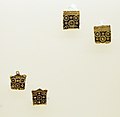
Etruria, goldsmiths from the archaic period, 6th century BC, box earrings 01
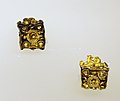
Etruria, goldsmiths from the archaic period, 6th century BC, box earrings 02
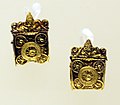
Etruria, goldsmiths from the archaic period, 6th century BC, box earrings 03

Etruria, goldsmiths of the classical and late classical period, 4th-2nd century BC, knitted necklace

Etruria, classical and late classical goldsmiths, 4th-2nd century BC, palmette necklace with amphora pendants, from cerveteri (gilded terracotta)
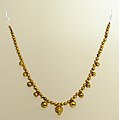
Etruria, goldsmiths of the classical and late classical period, 4th-2nd century BC, necklace with small spheres

Etruria, goldsmiths of the classical and late classical period, 4th-2nd century BC, necklace with clasp with protomes

Etruria, classical and late classical goldsmiths, 4th-2nd century BC, necklace with acorn pendant clasp

Etruria, classical and late classical goldsmiths, 4th-2nd century BC, ivy-leaf crown

Etruria, goldsmiths of the classical and late classical period, 4th-2nd century BC, crown with lanceolate leaves
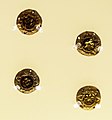
Etruria, goldsmiths of the classical and late classical period, 4th-2nd century BC, circular rosette decorations
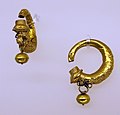
Etruria, oreficerie del periodo classico e tardo classico, IV-II secolo ac., orecchini a cornucopia, da ruvo di puglia

Etruria, goldsmiths of the classical and late classical period, 4th-2nd century BC, earrings with leonin protomes from cerveteri

Etruria, goldsmiths of the classical and late classical period, 4th-2nd century BC, pendants

Etruria, goldsmiths of the classical and late classical period, 4th-2nd century BC, breastplate with star and crescent-shaped bracts rebuilt by the castellans (surroundings of Bolsena)

Etruria, goldsmiths from the Hellenistic period, c. 310-100 BC, necklace with vague glass pastes millefiori 01
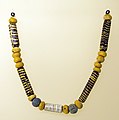
Etruria, goldsmiths from the Hellenistic period, c. 310-100 BC, necklace with vague glass pastes millefiori 03

Etruria, goldsmiths from the Hellenistic period, c. 310-100 BC, necklace with vague glass pastes millefiori 04

Etruria, goldsmiths from the Hellenistic period, c. 310-100 BC, necklace with vague glass pastes millefiori 05

Etruria, goldsmiths from the orientalizing period, 7th century BC, necklace with faience rings and gold pendants

Etruria, goldsmiths from the orientalizing period, 7th century BC, necklaces with pendants

Etruria, goldsmiths from the Hellenistic period, c. 310-100 BC, funeral wreath

Etruria, Hellenistic period goldsmiths, c. 310-100 BC, head with laurel wreath diadem

Etruria, goldsmiths from the Hellenistic period, c. 310-100 BC, oval shield earrings with a cluster hanging in rows of globes 01

Etruria, goldsmiths from the Hellenistic period, c. 310-100 BC, oval shield earrings with a cluster hanging in rows of globes 02
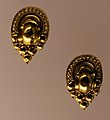
Etruria, goldsmiths from the Hellenistic period, c. 310-100 BC, oval shield earrings with a cluster hanging in rows of globes 03

Etruria, goldsmiths from the Hellenistic period, c. 310-100 BC, earrings with doves

Etruria, goldsmiths from the orientalizing period, 7th century BC, gold and amber necklaces, from cerveteri

Etruria, goldsmiths of the orientalizing period, 7th century BC, spiral braid holder 01

Etruria, goldsmiths of the orientalizing period, 7th century BC, spiral braid holder 02

Etruria, goldsmiths from the orientalizing period, 7th century BC, braid holder with granulation decoration

Etruria, goldsmiths from the orientalizing period, 7th century BC, amber fibulae with gold leaf 01

Etruria, goldsmiths from the orientalizing period, 7th century BC, amber fibulae with gold leaf 02

Etruria, goldsmiths from the orientalizing period, 7th century BC, amber fibulae with gold leaf 03

Etruria, goldsmiths from the orientalizing period, 7th century BC, amber and metal fibulae

Etruria, goldsmiths from the orientalizing period, 7th century BC, silver and gold fibulae

Etruria, goldsmiths from the orientalizing period, 7th century BC, gold and amber fibulae

Etruria, goldsmiths from the orientalizing period, 7th century BC, gold fibulae

Etruria, goldsmiths from the orientalizing period, 7th century BC, lamellae

Etruria, goldsmiths from the orientalizing period, 7th century BC, amber pendants with a female figure, from the galeassi tomb in palestrina

Etruria, goldsmiths from the orientalizing period, 7th century BC, amber pendants with crouching monkeys, from the galeassi tomb in palestrina

Etruria, goldsmiths from the orientalizing period, 7th century BC, bulla pendant

Etruria, goldsmiths from the orientalizing period, 7th century BC, pendant

Etruria, goldsmiths from the orientalizing period, 7th century BC, breastplate from the Galeassi tomb in Palestrina, re-worked by the Castellani 02

Etruria, goldsmiths from the orientalizing period, 7th century BC, breastplate from the Galeassi tomb in Palestrina, re-worked by the Castellani 022

Etruria, goldsmiths from the orientalizing period, 7th century BC, breastplate from the Galeassi tomb in Palestrina, re-worked by the Castellani 023

Iron Age, Piceni, Mid-Adriatic and Southern Italian jewellery, c. 800-690 BC, chain with spirals

Iron Age, Piceni, Mid-Adriatic and Southern Italian jewellery, c. 800-690 BC, necklace 06

Iron Age, Piceno, mid-Adriatic and southern Italian jewellery, c. 800-690 BC, necklace with rings and large amber pendant

Iron Age, Piceni, Mid-Adriatic and Southern Italian jewellery, c. 800-690 BC, necklace with bulle

Iron Age, Piceno, mid-adriatic and southern Italian jewelry, c. 800-690 BC, necklace with large amber vague

Iron Age, piceni, mid-adriatic and southern Italy jewelry, c.800-690 bc, necklace with arrowhead pendants, from norcia

Iron Age, Piceno, mid-adriatic and southern Italy jewellery, c. 800-690 BC, necklace with spirals

Iron Age, Piceni, Mid-Adriatic and Southern Italian jewellery, c. 800-690 BC, glass paste necklace 01

Iron Age, Piceni, Mid-Adriatic and Southern Italian jewellery, c. 800-690 BC, glass paste necklace 02

Iron Age, Piceni, Mid-Adriatic and Southern Italian jewellery, c. 800-690 BC, eyeglass fibulae

Iron Age, Piceni, Mid-Adriatic and Southern Italian jewellery, c. 800-690 BC, pendant 01

Iron Age, Piceni, Mid-Adriatic and Southern Italian jewellery, c.800-690 BC, pendant with horses, bulles and hands

Iron Age, Piceni, Mid-Adriatic and Southern Italian jewellery, c. 800-690 BC, pendant 01

Iron Age, Piceno, Mid-Adriatic and Southern Italian jewellery, c. 800-690 BC, breastplate with pendants

Iron Age, Piceni, Mid-Adriatic and Southern Italian jewellery, c. 800-690 BC, amber vague

Minoan gem with man with open arms between two animal-headed figures carrying amphorae, from tarquinia, 15th-14th century BC

Kotyle in gold with pairs of sphinxes, c. 675-650 BC, from the bernardini tomb in the necr. of the colombella in palestrina

Etruscan-museum-of-villa-giulia --- ori-castellani --- cameo 32476200292 o

Etruscan-museum-of-villa-giulia --- ori-castellani-etruscan-brooch 32627086395 o

Early medieval goldsmiths, approx. 590 AD, large stirrup fibula, from rieti

Early medieval goldsmiths, Goths, belt buckle with cloisonné almandins on gold leaf, c. 490 AD. 02

Early medieval jewellery, 5th-7th century, bracelet with globules

Early medieval jewellery, 5th-7th century, bracelet with small pyramids

Early medieval jewellery, 5th-7th century, glass paste necklace

Early medieval jewellery, 5th-7th century, belt buckle 06

Early medieval jewellery, 5th-7th century, belt buckle with almandines 03

Early medieval jewellery, 5th-7th century, belt buckle with drop almandines, from barete (AQ) 01

Early medieval jewellery, 5th-7th century, belt buckle with drop almandines, from barete (AQ) 02

Early medieval jewellery, 5th-7th century, belt buckle

Early medieval jewellery, 5th-7th century, disc fibulae

Early medieval jewellery, 5th-7th century, animal-shaped fibulae

Early medieval jewellery, 5th-7th century, S 01 fibulae

Early medieval jewellery, 5th-7th century, S 02 fibulae

Early medieval jewellery, 5th-7th century, stirrup fibulae 01

Early medieval jewellery, 5th-7th century, stirrup fibulae 02

Castellani goldsmiths, 27 pieces of antique jewellery, 19th century (rome, villa giulia) 01,1

Castellani goldsmiths, 27 pieces of antique jewellery, 19th century (rome, villa giulia) 01

Castellani goldsmiths, 27 pieces of antique jewellery, 19th century (rome, villa giulia) 02,2

Castellani goldsmiths, 27 pieces of antique jewellery, 19th century (rome, villa giulia) 02

Castellani golds, made in imitation of the ancient in part by incorporating original materials, 19th century, crest needle 01

Castellani golds, made in imitation of the antique in part by incorporating original materials, 19th century, bracelets

Castellani golds, made in imitation of the ancient in part by incorporating original materials, 19th century, fibula 01
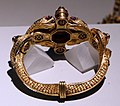
Castellani golds, made in imitation of the ancient in part by incorporating original materials, 19th century, bracelet 01

Castellani golds, made in imitation of the ancient in part by incorporating original materials, 19th century, bracelet 02

Castellani golds, made in imitation of the ancient in part by incorporating original materials, 19th century, necklace 01

Castellani golds, made in imitation of the ancient in part by incorporating original materials, 19th century, necklace 02

Castellani golds, made in imitation of the ancient in part by incorporating original materials, 19th century, necklace 03

Castellani golds, made in imitation of the ancient in part by incorporating original materials, 19th century, necklace 04

Castellani golds, made in imitation of the ancient in part by incorporating original materials, 19th century, necklace 05

Castellani golds, made in imitation of the ancient in part by incorporating original materials, 19th century, necklace 06

Castellani golds, made in imitation of the ancient in part by incorporating original materials, 19th century, necklace 07

Castellani golds, made in imitation of the ancient in part by incorporating original materials, 19th century, necklace 08
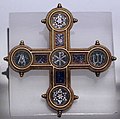
Castellani golds, made in imitation of the ancient in part by incorporating original materials, 19th century, pectoral cross

Castellani golds, made in imitation of the antique partly by incorporating original materials, 19th century, fibula with winged lion and ducks
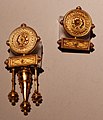
Castellani golds, made in imitation of the antique in part by incorporating original materials, 19th century, earrings 01

Castellani golds, made in imitation of the ancient in part by incorporating original materials, 19th century, ship earrings with bunches

Castellani golds, made in imitation of the ancient in part by incorporating original materials, 19th century, brooch 01

Castellani golds, made in imitation of the ancient in part by incorporating original materials, 19th century, brooch 02

Castellani golds, made in imitation of the ancient in part by incorporating original materials, 19th century, brooch 03

Castellani golds, made in imitation of the ancient in part by incorporating original materials, 19th century, brooch 04

Castellani golds, made in imitation of the ancient in part by incorporating original materials, 19th century, brooch with a Gothic style cameo

Castellani golds, made in imitation of the antique partly by incorporating original materials, 19th century, brooch with micromosaic owl

Part of a necklace with amber beads and silver pendants, from the Castellani Tomb in Palestrina, c. 700-675 BC. 01

Part of a necklace with amber beads and silver pendants, from the Castellani Tomb in Palestrina, c. 700-675 BC. 02

Gold plate with stylized animals, c. 675-650 BC, from the Barberini tomb in the necr. of the colombella in palestrina
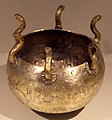
Small lebete with snake heads and engravings of birds, warriors and knights, silver, c. 675-650 BC, from t. bernardini necr. of the colombella in palestrina

Late Mycenaean blue glass diadem plaques, from Rhodes, 14th-13th century BC

Rome, republic or empire, goldsmiths, 1st century BC-3rd AD, rings 01
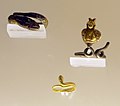
Rome, republic or empire, goldsmiths, 1st century BC-3rd AD, snake rings and with a bust of osiris

Rome, republic or empire, goldsmiths, 1st century BC-3rd AD, iron key rings for soldiers responsible for castra

Rome, republic or empire, goldsmiths, 1st century BC-3rd AD, snake armilla

Rome, republic or empire, goldsmiths, 1st century BC-3rd AD, necklace

Rome, republic or empire, goldsmithery, 1st century BC-3rd AD, gold and precious stone necklaces

Rome, republic or empire, jewellery, 1st century BC-3rd AD, earrings with pendants

Rome, republic or empire, goldsmiths, 1st century BC-3rd AD, scepter with eagle's head 01

Rome, republic or empire, goldsmiths, 1st century BC-3rd AD, scepter with eagle's head 02
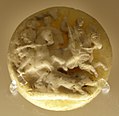
Rome, republic or empire, goldsmiths, 1st century BC-3rd AD, ivory tondo with Calydonian hunting

Skiphos in silver foil, from the castellani tomb in palestrina, c.700-675 BC
References[]
- ^ Ignazio Caruso, Collezione Castellani. Le oreficerie. Museo Nazionale Etrusco di Villa Giulia, Roma 1988.
- ^ Pompeo Fabri, Il marchese Campana. Fallito tentativo di costituzione di una Soc. An. per Azioni onde impedire l'esodo all'estero delle sue collezioni, in Strenna dei Romanisti, vol. 15, Roma, Staderini Editore, 1954, pp. 181-185.
- ^ Marina Bertoletti, Maddalena Cima, Emilia Talamo, Centrale Montemartini. Musei Capitolini, Roma 1997
- ^ Elizabeth Simpson, "Una perfetta imitazione del lavoro antico", Gioielleria antica e adattamenti Castellani. In: I Castellani e l'oreficeria archeologica italiana, Op. cit, pp. 177-200
- ^ Edilberto Formigli, Wolf-Dieter Heilmeyer, «Einige Faelschungen antiken Goldschmucks im 19. Jahrhundert», Archaeologischer Anzeiger 1993, pp. 299-332
- ^ L'arte nella industria, Roma: Tip. Elzeviriana, 1878
- ^ Luigi Mosca, Napoli e l'arte ceramica dal XIII al XX secolo: la riforma dei musei artistici-industriali, Napoli: R. Picciardi, 1908, p. 116
- ^ Torquato Castellani, Le industrie dei silicati, 1925
- ^ De Mauri, L'amatore di maioliche e porcellane. p. 198
- ^ Ignazio Caruso, Collezione Castellani. Le oreficerie. Museo Nazionale Etrusco di Villa Giulia, Roma 1988.
- ^ Edilberto Formigli, Wolf-Dieter Heilmeyer, «Einige Faelschungen antiken Goldschmucks im 19. Jahrhundert», Archaeologischer Anzeiger 1993, pp. 299-332
Bibliography[]
- G. Bordenache Battaglia, «CASTELLANI». In: Dizionario Biografico degli Italiani, Roma: Istituto della Enciclopedia Italiana, 1978 (on-line).
- Ministero per i Beni e le Attività culturali, Soprintendenza per i Beni Archeologici del Lazio, I Castellani e l'oreficeria archeologica italiana : New York, the bard graduate center for studies in the decorative arts, 18 novembre 2004-6 febbraio 2005; Londra, Somerset house, 5 maggio-18 settembre 2005; Roma, Museo Nazionale Etrusco di Villa Giulia, 11 novembre 2005-26 febbraio 2006, Roma: "L'Erma" di Bretschneider, 2005. ISBN 88-8265-354-4 (Google books).
- Sante Guido, L'oreficeria sacra dei Castellani in Vaticano, Città del Vaticano: Edizioni Capitolo Vaticano, 2011 - (Archivium Sancti Petri). ISBN 9788863390223.
- Sante Guido, Il Calice Castellani nel Museo della Basilica Papale di Santa Maria Maggiore , Roma: Lisanti Editore - (Studia Liberiana IV). ISBN 9788890583810.
External links[]
- Italian goldsmiths
- Italian potters
- Italian collectors
- People from Rome
- Italian families















































































































